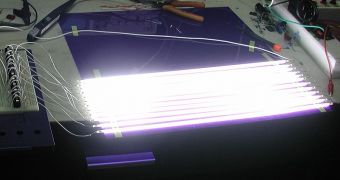Unlike typical cathode ray displays that produce images on a screen by bombarding electrons into a layer of phosphorous, liquid crystal displays can't actually produce their light while functioning. This is because the pixels on an LCD are basically like little shutters that vary their opacity accordingly to the amount of electric current they receive.
This disadvantage is especially visible in the case of old-fashioned monochrome liquid crystal displays, which can be read only when they are lit with light coming from the environment, and become totally useless in the absence of it. In this case, light coming from the Sun or reflected by the environment enters the LCD, passes through all the layers of the display before encountering a reflective surface that sends the light back to the viewer.
In more advanced color LCDs however, the lighting problem is solved by placing a light source behind the color pixel panel. Typical LCD panels use as light source a single straight glass tube known as a cold cathode fluorescent lamp, which works much in the same way as regular fluorescent lamps. The tube usually contains a low-pressure mercury vapor that, when ionized, starts to emit ultraviolet light. Human eyes cannot see in ultraviolet wavelengths, thus a coat of phosphorus inside the tube ensures that the ultraviolet light is then converted into bright white light.
The light produced by the CCFL tube is used to shine a diffusion panel, which then scatters light evenly across the whole surface, thus providing the LCD with uniform amounts of light.
Cold Cathode Fluorescent Lamps
Fluorescent lamps generally use heated elements in order to produce light and to ionize the gas discharge mixture. CCFLs on the other hand do not require such constructive elements, therefore, as their name says, they do not produce heat while generating electrons. To achieve electron emission nonetheless, CCFLs harness an effect known as thermionic emission. In thermionic emission, the electrons are generated in the presence of a sufficiently high voltage.
This doesn't mean however that CCFLs must necessarily remain cold during operation. If fact the can get extremely hot, red hot even, due to electrons impacting the anode of the device.
What makes CCFLs ideal for the use in LCDs is that they have sizes comparable to that of a lead pencil, are somehow much tinner than the latter, and can produce very high amounts of light. Also, CCFLs are extremely sensitive to physical shocks, so if you drop an LCD panel and it doesn't light up anymore, the light source is most likely broken.

 14 DAY TRIAL //
14 DAY TRIAL //